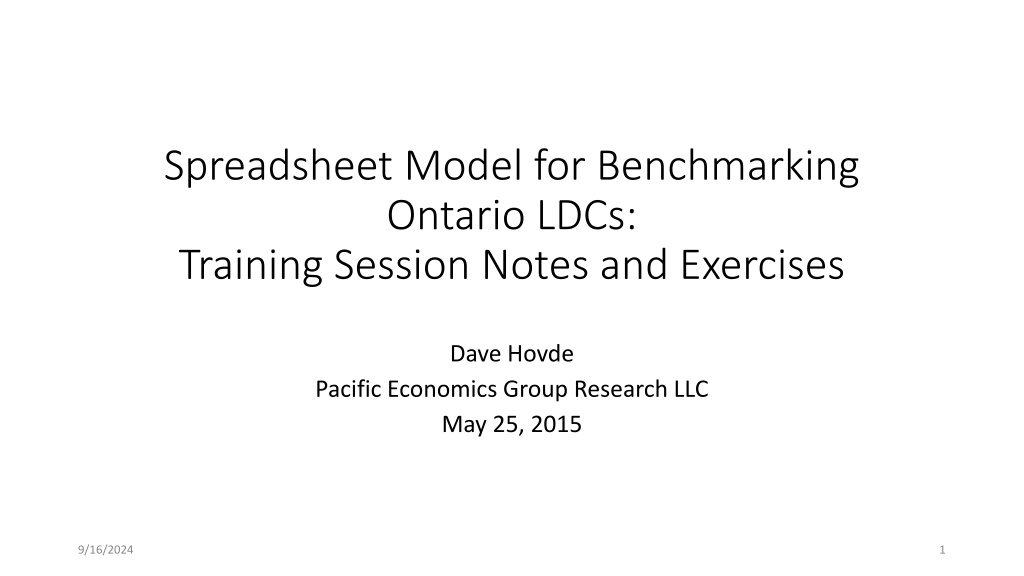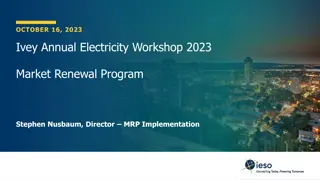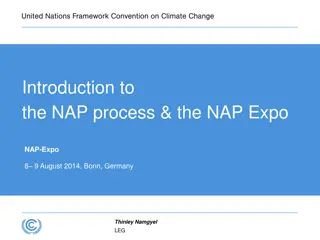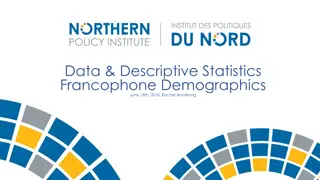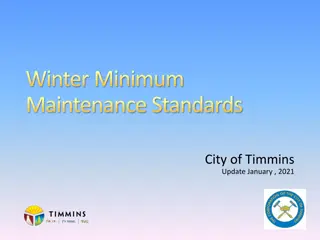Training Session Notes: Spreadsheet Model for Benchmarking Ontario LDCs
Training session notes and exercises on a Spreadsheet Model for Benchmarking Ontario Local Distribution Companies (LDCs). The session covers an overview of calculations, validation, forecasting, and tools available. The document outlines the organization of the session and conventions used in the presentation. It also highlights improvements in the working papers, evolution of supporting documents, and collaboration processes. The work aims to help LDCs understand and validate calculations for benchmarking analysis.
Download Presentation

Please find below an Image/Link to download the presentation.
The content on the website is provided AS IS for your information and personal use only. It may not be sold, licensed, or shared on other websites without obtaining consent from the author. Download presentation by click this link. If you encounter any issues during the download, it is possible that the publisher has removed the file from their server.
E N D
Presentation Transcript
Spreadsheet Model for Benchmarking Ontario LDCs: Training Session Notes and Exercises Dave Hovde Pacific Economics Group Research LLC May 25, 2015 9/16/2024 1
Part 1: Overview 9/16/2024 2
Overview of the Training Session Introduction Goals: Provide an overview of the Spreadsheet Model and the User s Guide Provide enough detail to show the level of complexity involved Show some of the tools available to overcome this complexity Plan: Overview of Calculations Validation Worksheet Forecasting and Other Tools 9/16/2024 3
Organization of the Session 1. Introduction and overview 2. Validation 1. Section 1: data entry 2. Section 2: actual cost calculation 1. OM&A calculation exclusions and adjustments 2. Capital Calculation 3. Section 3: Predicted Cost 4. Section 4: Cost Performance Calculation 3. Validation Exercise 4. Flowchart, Generic LDC worksheet, and Forecasting 9/16/2024 4
Conventions used in the presentation Numbers in Brackets [ ] indicate the section of the User s Guide where additional information can be found. A number with a zero after the decimal (e.g. 3.0) refers to the entire section. Numbers in Parentheses ( ) indicate the line reference number on the validation worksheet. These reference line numbers are those contained in column B and not those generated by Excel. 9/16/2024 5
Improvements to the Working Papers Evolution of the Supporting Documents The PEG Reports User Guide Working Papers Spreadsheet Model Collaborative Process with and LDC subcommittee and OEB Staff Validation has been made easier through the addition of a separate worksheet that considers a single company instead of all companies A Users Guide has been developed to help explain the calculations and provide background on the methods used Forecasting capability has been added to allow LDC staff to project future cost performance 9/16/2024 6
Proper Use of this Work This work is intended to support the efforts of LDC to understand and validate certain calculations presented on their scorecards The methods and data used in the benchmarking analysis were chosen to support comparisons among power distributors in Ontario Other uses of the data outside of this context are not intended and will very likely not yield any meaningful results Examples of meaningless comparisons include: A comparison of the cost levels in this analysis to cost and revenue levels produced for financial reporting purposes A comparison of these cost levels to revenue requests made in conjunction with custom IR filings 9/16/2024 7
Default Rate Escalation Formula [1.1] Rates are escalated by inflation less an amount based upon productivity and a stretch factor The Board determined an appropriate productivity factor was 0% The stretch factors range from 0% to 0.6% and are assigned based upon the cost performance of each LDC This stretch factor represents an amount of additional productivity above average productivity that is expected of an LDC Distributors with good measured cost performance have fewer opportunities to reduce cost Section 1.1 and Appendix 2 of the User s Guide has additional discussion 9/16/2024 8
Stretch Factor Groups [1.2] The Board determined that stretch factors would be assigned based on an LDCs average cost performance over three years Group 1: more than 25% Better than Average Group 2: 10% to 25% Better than Average Group 3: Within 10% of Average Group 4: 10% to 25% Worse than Average Group 5: more than 25% Worse than Average 9/16/2024 9
How Cost Benchmarking Works [1.3] An Actual total cost is calculated for benchmarking purposes A statistical model is developed that seeks to predict the cost of any LDC based on a set of factors identified by the model to be related to cost. These include: Wages and other prices of inputs purchased by the LDC A price of capital services Outputs such as Customers Served, Deliveries, and System Capacity Other business conditions The percentage difference between Actual and Predicted cost is how cost performance is measured 9/16/2024 10
How is Cost Performance is Determined Cost performance is the difference between actual cost and that predicted by the econometric model The calculations for each piece can be examined independently Performance Predicted Cost Actual Cost 9/16/2024 11
Overview of the Cost Benchmarking Method Econometric Model Parameters OM&A Expense Benchmarking Result Actual Cost Calculation Predicted Cost Calculation Input Prices and Business Conditions Capital Cost Stretch Factor 9/16/2024 12
Overview of the Spreadsheet Model The spreadsheet model will collect the required data and calculate cost performance It contains the working papers for the 2013 update and adds additional worksheets including: A Validation worksheet Data section Actual cost calculation Predicted cost calculation Cost performance calculation Forecasting worksheets On the same worksheet as the validation Same calculations with different data 9/16/2024 13
Data Sources The data are gathered from other parts of the workbook Many of these contain the source data These are the same links made by the 2013 calculations sheet that does the calculations for all companies IRM-4 Working Papers Validation and Forecasting 2012 Database PBR Data RRR 2.1.7 Rollup RRR HV Charges, Acct 5014 5015 5112 RRR LV Charges, LV Pivot, HON LV Charges Hydro One Networks 2.1.2 Customer Numbers RRR EUCPI, AWE, GDP IPI FDD Statistics Canada 9/16/2024 14
Overview of the Users Guide Table of Contents Background Detailed coverage of each worksheet Validation Forecasting Generic LDC Flowchart Glossary and other Appendixes 9/16/2024 15
Part 2: Validation Worksheet 9/16/2024 16
The Validation Worksheet [3.0 - 4.0] It uses the same formulas as the 2013 working paper and obtains the same results It was added to allow for a cleaner presentation of the calculations and allow a distributor to focus on just their company s data instead looking at calculations 70+ LDC It is organized into 4 sections: A data gathering section [3.1] A section to calculate actual cost [3.1] A section to calculate predicted cost [4.1-4.2.1] A section to calculate cost performance 9/16/2024 17
Validation Worksheet: Section 1 Section 1 collects all the required LDC data OM&A by account Not all OM&A accounts are included Bad Debt Most CDM Depreciation/Amortization Taxes and Payments in Lieu of Taxes HV OM&A is removed for comparability LV charges paid by to Hydro One Networks are added to OM&A 9/16/2024 18
Validation Worksheet: Section 1 (continued) Output Data Number of Customers Delivery Volume Peak Demand (used in the capacity calculation) Other Data Km of line All LDC data used to update the results is in Section 1 The first Level of Validation is to review and validate the data in Section 1 9/16/2024 19
Validation Worksheet: Section 2 Section 2: Actual Cost Calculations OM&A as adjusted is pulled down from Section 1 Capital Cost Calculations Total Cost = OM&A + Capital The actual cost calculations can be examined using a top down method in which the it is broken down into components 9/16/2024 20
Decomposing Actual Cost [3.1] Actual cost is the sum of OM&A and capital cost OM&A used for benchmarking has been adjusted to make the comparisons among LDCs more fair Capital Cost is calculated as the product of a capital service price and a quantity of capital measure Actual Cost Capital Cost OM&A Cost (81) (98-108) Capital Price (99-102) Selected RRR Accounts (1-72) Capital Quantity (103-107) Adjustments to OM&A (75-80) 9/16/2024 21
Details of OM&A Cost [3.1] OM&A cost contains adjustments Some adjustments are implicit because certain RRR accounts were not included Bad Debt and some CDM Amortization and Taxes Some adjustments are explicit LV charges HV charges Adjustments to OM&A (75-80) HON LV Charges HV OM&A (80) (76-79) 9/16/2024 22
Capital Cost Calculations: Plan for Review Brief discussion of different standards of validation Discuss the method used to obtain capital cost Introduce the data involved Show how the IRM-4 data are updated Go back and show how the IRM-4 data are calculated 9/16/2024 23
Validation Standards Each LDC will have its own standard for what is required to validate their scorecards The following are examples of different standards Level 1: Black Box (bare minimum) Validate the LDC data that was used in the analysis. Check the end result Level 2: Validate the Update (Model Designed for this level) Level 1 plus checking all formulas and understanding the methods Treats the IRM-4 work as data inputs Level 3: Level 2 plus Validate the Relevant IRM-4 Data 9/16/2024 24
Capital Cost Calculations: Data Construction Cost Index (101) From Statistics Canada Measures the Trend in LDC construction cost Rate of Return (99) As determined by the Board Put on a calendar year basis Depreciation Rate (100) Geometric not Straight Line The capital quantity index and construction cost index from the IRM-4 work (101,107) 9/16/2024 25
Capital Cost Method (99-108) Cost = Price x Quantity (108) Quantity: A perpetual inventory method is used which continually updates the quantity of capital over time (107) Price: This reflects how much it would cost to rent a unit of capital that the LDC owns. It has a rate of return and depreciation component (102) This method is used by the Bureau of Labor Statistics to calculate the multifactor productivity of the U.S. economy This method is used to allow for better comparisons among distributors This standardized capital cost is not intended to be used for other purposes such as an alternate revenue requirement Such a use would be erroneous and easily dismissed in my opinion 9/16/2024 26
Capital Cost Calculations: Quantity Capital Cost = Capital Quantity x Capital Price The quantity is based on the perpetual inventory method It starts with the previous years quantity of capital It adds the new capital quantity (calculated as Cost / Price) It removes the depreciated quantity (4.59% of previous years quantity) The capital quantity is designed to measure the amount of capital used by the LDC This will include the amount already paid for by customers 9/16/2024 27
Capital Cost Calculations: Capital Price Capital Cost = Capital Quantity x Capital Price The price is a rental price for capital It is what it would cost the LDC to rent the capital is actually owns in a competitive market for used assets The renter recovers a rate of return on the current value of its assets The renter recovers an amount to cover the depreciation of its assets The value of its assets is the current market value of its depreciated asset base The use of the construction cost index means that the units of the price index is not in dollars. It also means that the quantity index is expressed in units that are related to the index value However, the product of the price and quantity will result in dollars because the units of the construction cost index cancel out in the calculation of P x Q 9/16/2024 28
Details of Capital Quantity [3.1] Cost of Plant = Price x Quantity A construction cost index is used as the price The quantity is Cost / Price It relies upon previous calculations of quantity going back to 1989 It is updated each year to include the quantity of new plant and remove depreciated plant Capital Quantity (107) Previous Capital Quantity (107) Quantity Added Quantity Removed (105) (106) Gross Additions Depreciation Rate (103-104) (100) Construction Price Previous Capital Quantity (107) (101) 9/16/2024 29
CALCULATION OF THE ECONOMIC DEPRECIATION RATE Distribution Poles and Wires Line Transformers Services and Meters General Plant Equipment Information Total Plant Substations Technology Industry Total (2011) $ 1,106,968,267 $ 12,984,407,954 $ 3,852,700,174 $ 1,816,079,550 $ 530,943,619 $ 998,075,226 $ 818,062,952 $ 22,107,237,742 Percent of Total 5.0% 58.7% 17.4% 8.2% 2.4% 4.5% 3.7% 100.0% Hulten-Wykoff Parameter [A] 1.65 0.91 1.65 1.65 0.91 1.65 1.65 Life [B] 45 50 45 35 50 10 4 Rate [A/B] 3.67% 1.82% 3.67% 4.71% 1.82% 16.50% 41.25% 4.59% 9/16/2024 30
Details of Capital Price [3.1] The capital price contains terms to measure the need to cover debt cost, equity cost, and depreciation The rate of return is the weighted average cost of capital as determined by the Board. Monthly values are weighted to arrive at an annual value The depreciation rate was determined during IRM-4 and is the same for all distributors Capital Price (102) Rate of Return (99) Construction Cost Index (101) Depreciation Rate (100) 9/16/2024 31
Rate of Return Calculations Weighted Average Cost of Capital Med.-Small ($100M - $250M) Med. Large ($250M - Med.-Small ($100M - $250M) Med. Large ($250M - Small (< $100M) Large (> $1B) Small (< $100M) Large (> $1B) Board Return on Equity 9.35% Long-term Debt Rate Short-Term Debt Rate $1B) $1B) Issue Date Apr-99 RP-1998-0001 Decision RP-1999-0034 Decision EB-2006-0088 Methodology Mar-00 May-06 May-08 May-09 May-10 May-11 Jan-12 May-12 Jan-13 May-13 9.88% 9.00% 8.57% 8.01% 9.85% 9.58% 9.42% 9.12% 8.93% 8.98% 7.25% 6.25% 6.10% 7.00% 6.00% 6.10% 6.90% 5.90% 6.10% 6.80% 5.80% 6.10% 8.21% 7.26% 7.02% 7.52% 7.31% 6.91% 6.66% 6.20% 5.91% 5.98%Updated by PEG using OEB memorandum 8.57% 7.63% 8.30% 7.35% 8.09% 7.14% 7.88% 6.92% 6.10% 7.62% 5.87% 5.32% 5.01% 4.41% 4.03% 4.12% 4.47% 1.33% 2.07% 2.46% 2.08% 2.08% 2.08% 2.07% EB-2009-0084 Methodology (current) 2013 Average Value 5.96% 9/16/2024 32
More on the Capital Cost Methodology The capital cost is based on the purchase of capital services It is designed to estimate how much it would cost to rent the capital that the distributor owns assuming a competitive market for assets The depreciation profile has a geometric pattern and mimics the value of assets over time as they age This method is used by the U.S. Bureau of Labor Statistics in Multifactor Productivity Calculations More information can be found in the PEG IRM-4 report and the Appendix 1 to the User s Guide 9/16/2024 33
Overview of the IRM-4 Working Papers These are much more involved Include productivity calculations Do not include benchmarking calculations Does include benchmarking database used for the econometric model It has its own set of documentation Because the capital is the most important item carried forward, the discussion will be focused on capital related issues 9/16/2024 34
Capital Cost Calculations in the IRM-4 Working Papers A brief tour of the IRM-4 working papers and documentation One cannot rely upon the previous value of the capital quantity forever. There will eventually have to be a value calculated using a different method. This value is called the benchmark year value. These calculations were done in 1989 for most LDCs and in 2002 for LDCs that did not have sufficient historical data. There were many challenges that had to be overcome in order to produce the historical capital quantities 9/16/2024 35
Historical Data Challenge 1: Missing Additions Data This problem was overcome by estimating the additions data The estimate was based on the following accounting relationship Plant at End of Year = Plant at Start of Year + Plant Added Plant Retired Therefore: Plant Added = Plant at End of Year - Plant at Start of Year + Plant Retired Plant value data were available for many years Plant retired was estimated as 0.05% of plant each year 9/16/2024 36
Historical Data Challenge 2: Missing Data from 1998-2001 All LDCs did not have plant data for 1998-2001 This problem was addressed by using the same method to obtain plant additions except that the amount of additions from the calculation were over a multi-year period These were allocated equally to each of the missing years This method did not produce sensible results for all LDC Many LDC restated their plant values in 2002 at depreciated values This lead to a decline in plant and negative implied additions An alternate method produced a consistent 2002 plant value and additions in these cases 9/16/2024 37
The Benchmark Year for Capital Quantity The 1989 benchmark quantity of capital is calculated as Net Plant Value / Price at which the Net Plant Value was accumulated This price is estimated as a weighted average of the historical values of the construction cost index In order to minimize the effect of this assumption, it is very desirable to go back as far as possible In the case of Ontario, the MUDBANK database was the earliest available data. It starts in 1989 which is the benchmark year chosen 9/16/2024 38
Other Data from the IRM-4 Working Papers The capacity proxy variable The historical OM&A price index 9/16/2024 39
Review of Section 2 of the Validation Worksheet Actual Cost can be broken down into manageable pieces OM&A contains adjustments Capital Cost uses a methodology that standardizes the calculation such that plant added is the main driver of cost differences among distributors Some reliance upon previous work is required 9/16/2024 40
Section 3: Predicted Cost This is the most challenging section It involves the use of an equation that has already been determined in IRM-4 It is a complex implementation of a easier to understand method Models can be used to predict all sorts of things: What consumers are likely to buy Athletic Team Performance Forecasts of Economic Growth Let s start with a simple model that is not related to LDC cost 9/16/2024 41
Hockey Attendance Model Assume someone went to the effort to gather data with the goal to predict the attendance at a typical NHL hockey game A model was estimated and it found the following relationship between attendance (A) and a set of business conditions: Population / Average NHL market population (P) Winning Percentage in the previous 30 days (W) Number of All Star Players (S) Area Capacity / Average NHL Arena Capacity (C) A = 6000 + 100xP + 100xW + 1000xWxW+ 500xS + 100xC 9/16/2024 42
Hockey Attendance Model On any given night the predicted number of fans can be determined by plugging in the values for the Team A team with a 0.500 record, an average arena and population size with 1 all star would imply the following: P = 1; W = 0.500; WxW = 0.250 S = 1; C = 1; Because: A = 6000 + 100xP + 100xW + 1000xWxW + 500xS + 100xC Prediction: A = 6000 + 100x1 + 100x0.500 +1000x0.250 + 500x1 + 100x1 A = 6000 + 100 + 50 + 250 + 500 + 100 = 7000 Fans in Attendance The equation would predict the incremental impact of signing an all- star would by 500 fans. 9/16/2024 43
The LDC Cost Model vs. the Hockey Model An equation has been estimated that determined the impact of a number of business conditions By plugging in the values for the LDC or Team a prediction can be generated There may be factors that the model does not pick up or did not find significant (Weather that day; Who is the opposing team). If attendance is consistently better than the model predicts, perhaps team management is doing something better than everyone else to generate excitement for the team. The cost performance model is the same in that it attributes differences between actual cost and that predicted by the model to management performance. 9/16/2024 44
Validation Worksheet: Section 3 (Predicted Cost) Gather Data Output Quantities Input Prices Other Business Conditions Calculation of the prediction equation is done in 4 blocks This result is converted into dollars 9/16/2024 45
Predicted Cost Calculations Top to Bottom Overview of the Method What goes into the final result Looks like a pyramid (one result with many component calculations) How did we get this number Bottom to Top Review of Calculations How to get from the data provided to the final result Looks like a funnel (many variables to one result) What do these numbers imply We will start with the Top to Bottom Approach 9/16/2024 46
How Predicted Cost is Determined Predicted Cost in Dollars cannot be obtained directly for the results of the econometric model The model produces real cost It is expressed in logarithmic form It must be converted to normal nominal dollars Predicted Cost (234) OM&A Price (233) Real Predicted Cost (232) (used convert nominal to real) Natural Logarithm of Real Predicted Cost (231) 9/16/2024 47
How Real Predicted Cost is Determined It is the sum of the products of the parameter values and the business conditions These include variables that are constructed from data provided Constant and trend variables are also included Natural Logarithm of Real Predicted Cost (231) Estimated Parameters (148-165) Variables constructed from business conditions Constant and Trend Variables (191,208) (192-207) 9/16/2024 48
Variables Constructed from the Data The variables are constructed from transformed data. They include: The real price of capital Output measures Customers Deliveries Capacity Proxy Average line length Customer Growth The squares of outputs and price The products of outputs and price Variables constructed from business conditions (192-207) Prices and Square of Prices (192,196) Output and Square of Output Input Prices x Output Quantities Other Business Conditions (193-195,197-199) (200-205) (206-207) 9/16/2024 49
Transforming the Data to be Consistent with how the Model was Estimated Every variable except the time trend and constant needs to be transformed It is compared to the sample average (except the customer growth variable) The logarithm is taken (for all except the constant and trend) natural logarithm of (X/Average X) X X / Average X 9/16/2024 50
